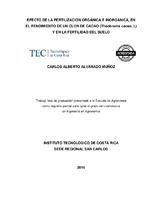Mostrar el registro sencillo del ítem
Efecto de la fertilización orgánica e inorgánica, en el rendimiento de un clon de cacao (Theobroma cacao, L) y en la fertilidad del suelo
| dc.contributor.author | Alvarado-Muñoz, Carlos Alberto | |
| dc.date.accessioned | 2018-07-31T20:05:43Z | |
| dc.date.available | 2018-07-31T20:05:43Z | |
| dc.date.issued | 2016 | |
| dc.identifier.uri | https://hdl.handle.net/2238/9843 | |
| dc.description | Trabajo Final de Graduación (Licenciatura en Ingeniería en Agronomía).Institutto Tecnológico de Costa Rica, Escuela de Agronomía. 2016 | es |
| dc.description.abstract | Applications of ammonium nitrate (33.5% N), as a source of nitrogen, phosphate rock (30% P2O5, 40% CaO, 10% SiO) as a source of phosphorus, potassium chloride (60% K2O, 45% Cl) as a source of potassium, Bokashi as a source of solid organic fertilizer and liquid Biofer húmico® as an organic fertilizer on the cacao clone (Theobroma cacao L.) CATIE-R6 in the seventh year of production located in the northern region of Costa Rica, locally known as the “Huetar” region, between March 2015 and August 2016. Nine treatments at random with three replicationseach were implemented. Each experimental unit had four trees planted at a distance of three by three meters, for a density of 1111 trees per hectare. Chemical soil and foliar analyzes were performed to determine the effects of fertilization on the soil including the nutritional status of the plant and production components, such as the number of fruits per tree annually, fruit weight in grams, wet grain weight in grams per fruit, number of grains per fruit, grain index, dry grain kilograms per hectare annually, and stem circumference in centimeters. After one year from the initial evaluation in the variables of exchangeable acidity (cmol (+) / L) the null hypothesis was rejected with a p-value of 5% for the treatments with phosphate rock and for the treatments with the combination of nitrogen, phosphate rock and potassium. Meanwhile, the potassium concentration (cmol (+) / L) for the treatments with potassium, nitrogen and phosphate rock the null hypothesis is true. No significant change between treatments was found in the foliage analysis and production components. After analyzing the soil variables, it was determined that the pH of rocks with the combination treatment of nitrogen-potassium-phosphate was lower (5,12) than the pH of rocks with the potassium treatment (5,70); treatments with organic sources, have lower levels of acidity saturation percentage than the control group; also individual applications of the three inorganic sources (N, RF, K) have lower saturation percentages, exchangeable acidity and sourness than the combination of the three sources. Concentration levels of potassium in the soil increased when this element had the least amount of combinations with other sources, both organic and vii inorganic. Fresh fruit weight was higher when only potassium was applied, compared to the application of the three elements together (N-RF-K) and the amount of seeds per fruit was higher when nitrogen is applied withoutpotassium. | es |
| dc.language.iso | spa | es |
| dc.publisher | Instituto Tecnológico de Costa Rica | es |
| dc.subject | Abonos orgánicos | es |
| dc.subject | Producción agrícola | es |
| dc.subject | Plantaciones de cacao | es |
| dc.subject | Enfermedades de los cultivos | es |
| dc.subject | Mercados de exportación | es |
| dc.subject | Research Subject Categories::FORESTRY, AGRICULTURAL SCIENCES and LANDSCAPE PLANNING::Plant production | es |
| dc.title | Efecto de la fertilización orgánica e inorgánica, en el rendimiento de un clon de cacao (Theobroma cacao, L) y en la fertilidad del suelo | es |
| dc.type | tesis de licenciatura | es |


